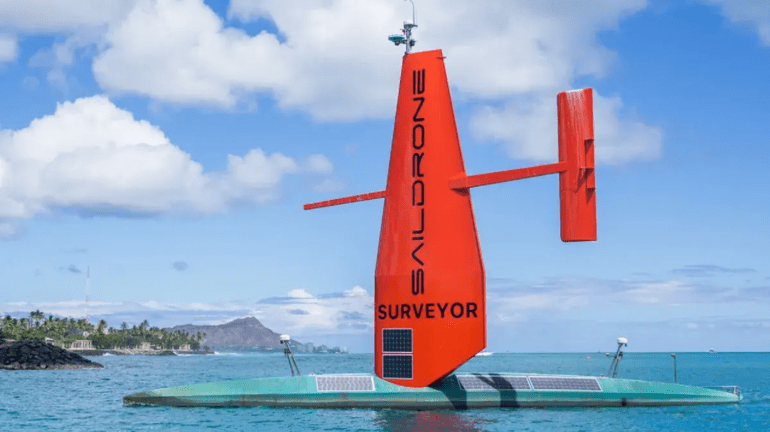TL;DR:
- Saildrone and RPS collaborate to create a surveillance network for marine wildlife protection in the context of offshore wind energy.
- Innovative technology combines acoustic solutions, autonomous vehicles, and machine learning.
- Two Saildrones are deployed off the coast of Massachusetts to observe North Atlantic right whales and other sea mammals.
- Passive acoustic technology and uncrewed platforms enable non-invasive and cost-effective data collection.
- Saildrones primarily run on solar and wind energy, making them ideal for long-term autonomous operations and various data collection tasks.
- RPS’s acoustic experts use machine learning to process and identify species emitting recorded calls.
- The project is supported by the National Offshore Wind Research and Development Consortium (NOWRDC) to ensure sustainable offshore wind development.
- Saildrones offer an environmentally friendly and cost-effective means to gather crucial ocean data.
Main AI News:
In the rapidly evolving landscape of offshore wind energy, concerns over potential disruptions to marine life have emerged as a pressing issue. The growing popularity of wind farms in the open sea raises questions about the impact of underwater noise on marine mammals’ ability to communicate with one another effectively. Addressing these concerns, Saildrone, a leader in underwater uncrewed surface vehicles (USVs), has joined forces with RPS, a provider of protected species monitoring and mitigation compliance services, to establish a cutting-edge surveillance network. This collaborative effort seamlessly combines state-of-the-art acoustic technologies, autonomous vehicles, and machine learning to protect marine life.
Saildrone and RPS have unveiled a groundbreaking initiative off the coast of Massachusetts, deploying two USVs to observe North Atlantic right whales and other sea mammals. This significant undertaking marks a pivotal advancement in our capacity to study and safeguard these majestic creatures. Brian Hernacki, Saildrone’s Chief Technology Officer, emphasizes the importance of Saildrone’s passive acoustic technology, enabling the collection of crucial data in a non-invasive and cost-effective manner. Paired with the mobility and endurance of their uncrewed platforms, this technology offers unparalleled monitoring capabilities, facilitating vital research, conservation efforts, and commercial ventures.
Saildrones, powered primarily by solar and wind energy, possess the capability for extended autonomous operations. Their onboard systems harness energy from solar panels, supplemented by wind propulsion, making them ideal for a wide range of data collection tasks. From fisheries management and weather forecasting to ocean and climate monitoring, Saildrones contribute significantly to the study of marine ecosystems.
Meanwhile, RPS’s team of acoustic experts takes on the crucial role of processing the data gathered by Saildrones. Using Neptune, a machine learning system, they identify the species emitting recorded calls with remarkable precision. This algorithmic approach offers an invaluable tool for the traceable detection of marine animal vocalizations.
The offshore wind industry’s global expansion plays a pivotal role in transitioning away from traditional, non-renewable power sources, particularly fossil fuels. However, this development must not come at the expense of marine mammals that share these habitats. Saildrone and RPS collaborate to deliver a unique, flexible, and adaptable solution for monitoring marine mammals over vast areas and extended periods. Their innovative approach reduces the need for personnel in the field while upholding rigorous monitoring and mitigation efforts to protect our marine animal neighbors, as emphasized by Stephanie Milne, RPS team leader for US Offshore Renewables.
This visionary project garners support from the National Offshore Wind Research and Development Consortium (NOWRDC), which strives to ensure that offshore wind power harmonizes with its surrounding environment. As the United States approaches the deployment of commercial-scale offshore wind farms, these projects offer tangible solutions to industry challenges. These solutions span stakeholder coordination to transmission resiliency. By harnessing the power of technology and innovation, a delicate equilibrium can be struck between sustainable economic development and the preservation of our fragile ecosystems, as articulated by Lyndie Hice-Dunton, Executive Director of NOWRDC.
Saildrones represent adaptable platforms that can be configured for a myriad of diverse tasks. Their capacity to gather data in challenging and isolated ocean conditions opens up new frontiers that may be too costly and perilous for crewed research vessels. Saildrone technology heralds a pioneering era in ocean exploration, providing affordable and environmentally friendly means to obtain crucial data from the world’s oceans, promoting a sustainable coexistence between clean energy and marine life preservation.
Conclusion:
The collaboration between Saildrone and RPS signifies a significant advancement in marine conservation and offshore wind energy. Their innovative approach, combining cutting-edge technology with sustainable practices, not only safeguards marine life but also supports the growth of the offshore wind industry. This synergy between environmental protection and renewable energy development sets a promising precedent, demonstrating that technological innovation can drive economic growth while preserving our fragile ecosystems.

